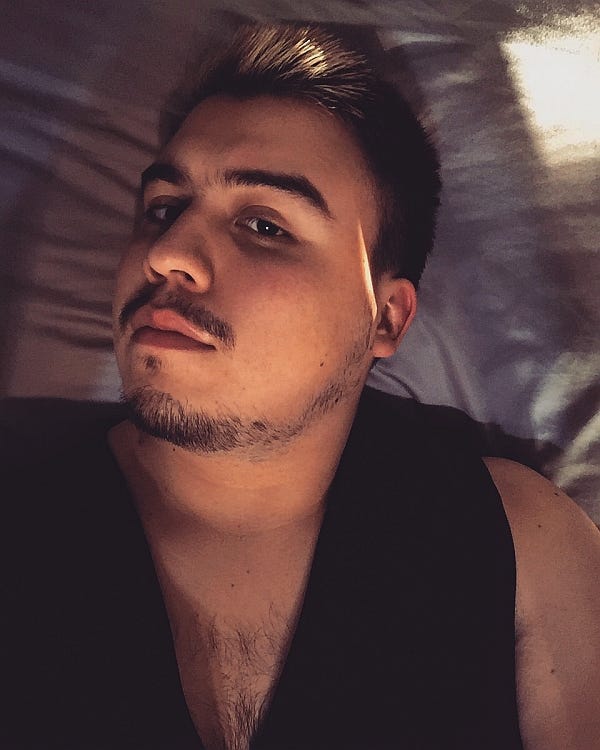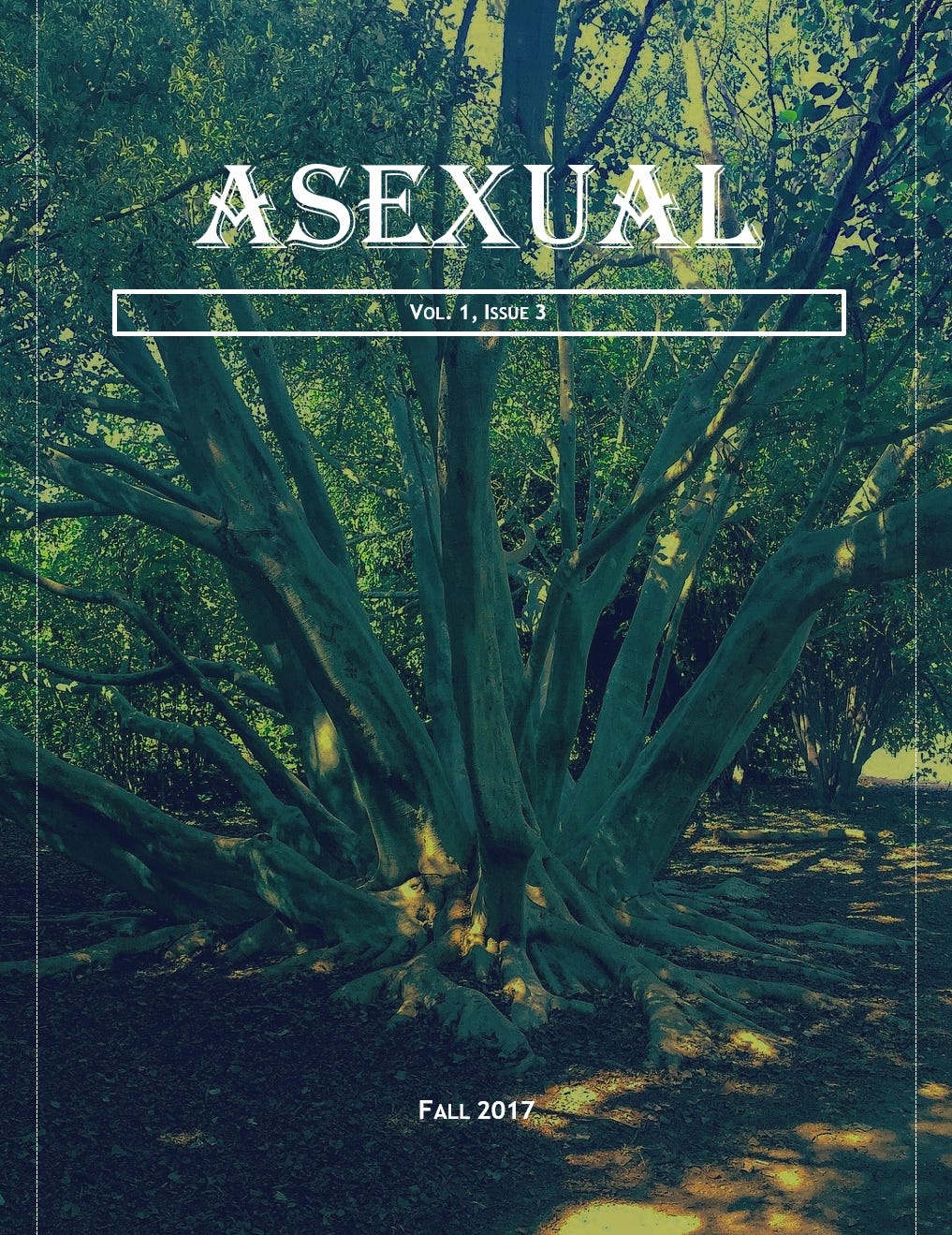“Centering ace perspectives and narratives”: an interview with Michael Paramo, founder of The Asexual

It’s Ace Awareness Week! The ace community reflects a diverse spectrum of folks who may not experience sexual attraction to others — though of course, many people define or experience their own asexuality differently. While this identity is often invisible, The Asexual is a new publication making space for visibility for Ace creators, including writers and artists. We talked to founder and editor-in-chief Michael Paramo. They shared the story behind The Asexual and reflected on how ace visibility can be more inclusive and intersectional.
Noah Fields: What’s the story behind The Asexual? How did it get started?
Michael Paramo: I am an obsessive person. I believe it is likely related to my autism, but nevertheless, it’s a trait that I possess. Interests or aspirations will frequently transform into obsessions. There is a comfort and pleasure, not only in the frequently required repetition of engaging in a particular interest or goal, but in the passionate intensity to which I will pursue them. Sometimes, as expected, this has concluded in disaster, in which my fascinations have consumed my life in destructive manners. More recently, I have been able to channel my passions into productivity. Still, it is maneuvering along that precarious edge — a balance between not enough and too much engagement — that remains a challenge.
I say this because The Asexual was birthed from obsession. I became obsessed with a desire to create a space for asexual people to share their narratives, creations, thoughts, and other representations of their soul. The project was initially fueled primarily by anger, frustration, depression, and so many other swirling emotional forces. As an asexual person, over the last few years, I had become exhausted by the droning sound or sight of invalidation. The Asexual became a production of exhaustion, a culmination of every comment, every aversion, every look, stare, silence, mock, and smirk. I knew that others had felt the same. I knew their experiences, stories, perspectives, and voices needed a space of expression.
I created The Asexual on October 5th, 2016 in a spontaneous fervor. I had no experience in designing a website or journal. I had only recently begun writing and publishing articles online. My editing experience was limited to non-existent. All I knew is that I wanted to transform the empty website before me into a vibrant space for ace writers and artists that was accessible to as many ace people as possible. In the beginning of this process, there were times that I questioned myself simply because of the magnitude of the project I had undertaken, but as soon as I had received my first few submissions for Vol. 1, Issue 1 of the journal, I knew there was no going back.

NF: What does The Asexual journal mean to you personally?
MP: I have often felt a deep connection to the submissions and comments I have received from writers, artists, and supporters of The Asexual. I have continued to hold many of them close to my heart, and they still motivate me onward, to ensure that other ace people will read inspiring work or receive similar comments as well. And that is what is really special to me about The Asexual. To me, it is more than just a quarterly journal, and I have been told this repeatedly by others.
Because of its focus on centering ace perspectives and narratives, whether through their written or visual work, it is a space and a community that advocates for and exemplifies, not just the validity of ace people and their experiences, but, more importantly, that their words, their art, their thoughts, their stories, their activism, their experiences, and their perspectives deserve to be shared and heard, both within and outside of the ace community.
I remain the sole manager of every facet of The Asexual, from the editor and layout manager of the journal, to the social media manager, to the submissions manager, to the article writer, for this larger purpose. And although it is difficult to manage my passions for The Asexual and my commitment to being a full-time graduate student, I have never been more thrilled to continue the work that I am doing.
NF: Tell us a little about the art and stories you’ve published. What new voices have you gotten excited about? What have you learned from your submissions?
MP: The Asexual has published three full issues so far, and over forty pieces total, the majority being poetry and essays, along with a few art pieces. The first two issues were completely open in topic while the latest was thematic, including a diverse body of work that focused on the intersections of asexuality and body. Some of these works have been self-reflective in a very personal way, others have been abstract, and others are more academic in their focus. I think there is a strength in a diversity of style, but a cohesion in theme, and that is what I hope to continue doing for future issues of the journal.
Throughout all of these issues, I have been excited by so many voices and perspectives from ace people, but especially those that are often not heard. For example, when I received submissions from ace people outside of the United States, and especially outside off the Anglosphere, I was thrilled to read and amplify their work. I also particularly have a strong love for every art submission that I receive, mostly because my mother is an artist and I feel a closeness with conveying meaning through imagery. Collectively, I have learned so much from all of the submissions to The Asexual. Every submission always offers a new angle or perspective, allowing me to think differently, both broadly and in relation to specific themes.
NF: What are your future goals for The Asexual journal?
On the agenda for the future of The Asexual is the development of a special yearly issue that focuses on a more specific intersection in relation to asexuality, in addition to the broad themes that the quarterly journal already currently considers. This project will add a fifth issue to the journal every year and will allow for those within the ace community who are often not represented to be centered via a cohesive body of work. Since every issue theme is chosen via voting by our readers and supporters, proposed issue themes that receive fewer attention are key indicators of which intersections should be explored more.
In a general sense, my future goals for The Asexual simply include its continuation and growth. Since the space is still fairly new, created only slightly more than a year ago, I am mostly concerned with maintaining the energy and time needed to solely continue to manage this project.
NF: What do you want more people to be aware of this Ace Awareness Week? Besides your journal of course. ;)
MP: Firstly, I believe that exposing people to the existence of asexuality is still important and necessary work that should remain the central goal of Ace Awareness Week. Because many people fundamentally believe in the idea that sexuality, or having sexual desire or experiencing sexual attraction, are biological truths that make us human, asexuality serves an important role in challenging these ideas. However, this brings me to my second point, which is that there must also be a recognition that all asexual or ace people are not the same.
Some ace people do experience sexual desire and some ace people do have sex. Some ace people are repulsed by sex and do not have sex. Some ace people are neutral to sex and never think about sex. Generally, I think more people need to recognize and understand the possibilities and complexities of asexuality and asexual identity. Yes, of course asexuality is valid. But, before you say this, how do you define asexuality?
Is your definition of asexuality inclusive of all ace people, whether sex-positive, sex-averse, sex-neutral, etc.? Are you aware that some ace people can and do have sex? Are you aware that some ace people are repulsed by sex? Are you aware that some ace people do engage in kink?
There are so many more intricacies and intersections that must be explored further, and this should be considered as a central focus during the course of Ace Awareness Week and beyond.
The Asexual journal publishes online content on their website, http://theasexual.com/. You can also find The Asexual on Facebook or follow them on Twitter.
Michael Paramo is a queer Latinx asexual disabled demiguy and graduate student. They are the editor-in-chief, layout editor, web designer, and social media manager of The Asexual. Their research was accepted for presentation by the Popular Culture Association, International Association for the Study of Popular Music, and National Women’s Studies Association.
Noah Fields is Assistant Blog Editor at Anomaly. They live in Chicago.
“Centering ace perspectives and narratives”: an interview with Michael Paramo, founder of The… was originally published in Anomaly on Medium, where people are continuing the conversation by highlighting and responding to this story.
